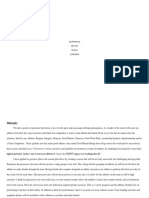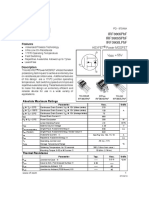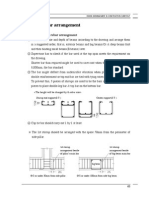0 ratings0% found this document useful (0 votes)
281 viewsBompa S Periodization For Sports Training
Bompa S Periodization For Sports Training
Uploaded by
Nicolae Dragos-AlexandruThis document discusses power training and methods for developing power. Power is defined as the ability to produce force quickly. Power training focuses on exercises performed as fast as possible, like Olympic lifts done in the 6x3 range. Methods for power development include the isometric method of lifting weights quickly, the ballistic method using medicine ball throws, the power resisting method using partners to provide resistance, and the plyometric method using plyometric and shock exercises. Plyometrics can train landing, reactive, throwing, jumping, starting, and acceleration power at different intensity levels over the long term.
Copyright:
© All Rights Reserved
Available Formats
Download as PPT, PDF, TXT or read online from Scribd
Bompa S Periodization For Sports Training
Bompa S Periodization For Sports Training
Uploaded by
Nicolae Dragos-Alexandru0 ratings0% found this document useful (0 votes)
281 views22 pagesThis document discusses power training and methods for developing power. Power is defined as the ability to produce force quickly. Power training focuses on exercises performed as fast as possible, like Olympic lifts done in the 6x3 range. Methods for power development include the isometric method of lifting weights quickly, the ballistic method using medicine ball throws, the power resisting method using partners to provide resistance, and the plyometric method using plyometric and shock exercises. Plyometrics can train landing, reactive, throwing, jumping, starting, and acceleration power at different intensity levels over the long term.
Original Title
270460779-Bompa-s-Periodization-for-Sports-Training.ppt
Copyright
© © All Rights Reserved
Available Formats
PPT, PDF, TXT or read online from Scribd
Share this document
Did you find this document useful?
Is this content inappropriate?
This document discusses power training and methods for developing power. Power is defined as the ability to produce force quickly. Power training focuses on exercises performed as fast as possible, like Olympic lifts done in the 6x3 range. Methods for power development include the isometric method of lifting weights quickly, the ballistic method using medicine ball throws, the power resisting method using partners to provide resistance, and the plyometric method using plyometric and shock exercises. Plyometrics can train landing, reactive, throwing, jumping, starting, and acceleration power at different intensity levels over the long term.
Copyright:
© All Rights Reserved
Available Formats
Download as PPT, PDF, TXT or read online from Scribd
Download as ppt, pdf, or txt
0 ratings0% found this document useful (0 votes)
281 views22 pagesBompa S Periodization For Sports Training
Bompa S Periodization For Sports Training
Uploaded by
Nicolae Dragos-AlexandruThis document discusses power training and methods for developing power. Power is defined as the ability to produce force quickly. Power training focuses on exercises performed as fast as possible, like Olympic lifts done in the 6x3 range. Methods for power development include the isometric method of lifting weights quickly, the ballistic method using medicine ball throws, the power resisting method using partners to provide resistance, and the plyometric method using plyometric and shock exercises. Plyometrics can train landing, reactive, throwing, jumping, starting, and acceleration power at different intensity levels over the long term.
Copyright:
© All Rights Reserved
Available Formats
Download as PPT, PDF, TXT or read online from Scribd
Download as ppt, pdf, or txt
You are on page 1of 22
Conversion to Power
• The final phase of the classical periodization
model before maintenance and active recovery
phases.
• Power is defined as the ability of the
neuromuscular system to produce the greatest
possible force in the shortest possible amount of
time.
• An athlete can be very strong, but but unable to
produce a large force in a short amount of time.
Power training
• Power training “trains” the CNS.
• Plyometrics and power related activity don’t
do a whole lot to assist in muscular
hypertrophy, although they can complement
weightlifting activities in the goal of achieving
increased functional cross-sectional area of
muscle.
Methods of power development in
power training
• Isometric Method: weights lifted quickly
• Ballistic Method: medicine ball throws
• Power Resisting Method: accumulate/release
weightlifting
• Plyometric Method: plyometric and shock
work
Power training: Lifting
• During power training, lifting weights is still
employed, but the weightlifting is performed as
fast as possible.
• Few exercises are chosen, so that more time can
be spent on technical and tactical aspects of that
sport.
• Although the book gives some different examples,
just a couple of olympic lifts performed in the 6x3
range will suffice for this phase.
Power training
• Weightlifting parameters
Power training and the ballistic
method
• Ballistic training involves the use of thrown
objects, such as medicine balls and shot puts.
• The difference between throwing medicine
balls and doing weightlifting exercises, aside
from the speed, is that, during weightlifting
exercises, the bar must be decelerated at the
top of the lift. In a medicine ball (and most
sporting movements, acceleration must be
provided all the way through the movement).
The ballistic method
• Typically, the ballistic method is not used as
the primary part of the training session.
• It is usually used, either directly after the
warmup, or at the tail end of the workout.
Ballistic method example
Power resisted method
• In the power/resisted method, lifts are done with
the use of partners to cause maximal tension and
then release it.
• An example would be the following: An athlete
squats down to parallel with 40% of his 1RM
squat on the bar. Two teammates push down on
the bar at the bottom and the athlete will push
up as hard as possible for 2-3 seconds(the bar
does not go anywhere). Then the teammates
suddenly release and the athlete pushes up as
fast as possible.
Power resisting method
• This works in a similar manner to the “finger
snap” example we learned earlier in class.
• In this type of exercise, the maximal amount
of actin/myosin cross bridges are activated,
allowing lots of tension to be built up in the
muscle, and then suddenly released in a
powerful motion.
• 2-4 Exercises might be used in this type of
workout.
Power resisting example
• Parallel Squats: 5 sets of 3 with 40% 1RM
• Bench Press Throw (smith machine): 5 sets of
3 with 40% 1RM
• Rack Pulls: 5 sets of 3 with 40% 1RM 5x3
• Flying Pullups (band assist): 5x3 with 40% 5x3
• This wouldn’t be done more than 2x a week.
Power/Resistance and oscillatory
isometrics
• Oscillatory isometrics are a close relative to
the power release method.
• In OI’s, the athlete will generate maximal
isometric tension on their own, and then
completely relax and allow the muscle group
to act reflexively.
• Examples
Plyometric method
• We have already learned much of plyometrics
in class.
• For this lecture we will cover the intensity
level of a few different types of plyometric
activities.
Plyometric intensity levels
Long term plyometric planning
Plyometrics teaching landing power
Reactive power
Throwing power
Jumping power
Starting power
Acceleration power
You might also like
- Sprint Hurdles An Introduction To Speed Strength Technical and Rhythm TrainingDocument26 pagesSprint Hurdles An Introduction To Speed Strength Technical and Rhythm TrainingJoão Pedro Adegas CarvalhoNo ratings yet
- The Farmers Handbook of Explosives USA 1911Document92 pagesThe Farmers Handbook of Explosives USA 1911boudicaf100% (2)
- Goran Obradovic Karlstad - Ivana Spanovic TrainingDocument10 pagesGoran Obradovic Karlstad - Ivana Spanovic TrainingAnonymous sYX58Brtc100% (2)
- Hamstring Rehabilitation in Elite Track and FieldDocument13 pagesHamstring Rehabilitation in Elite Track and FieldBarry Doe100% (1)
- Strength and Conditioning For The Triple Jumper.10Document7 pagesStrength and Conditioning For The Triple Jumper.10yohann GonsalvesNo ratings yet
- Speed Strength TemplateDocument2 pagesSpeed Strength Templatelemmedopeyuh100% (1)
- NomadlandDocument5 pagesNomadlandAllison44% (16)
- Book of Programmes for the Team Sport Athlete; Size & StrengthFrom EverandBook of Programmes for the Team Sport Athlete; Size & StrengthNo ratings yet
- Ozolin The Tech of The Sprint StartDocument5 pagesOzolin The Tech of The Sprint StartZachary LeeNo ratings yet
- Dennis Mitchell-Melding The Phsyical and Mental Components of SprintingDocument1 pageDennis Mitchell-Melding The Phsyical and Mental Components of SprintingChris NickinsonNo ratings yet
- UKA Exercise Classification Hierarchy V1.0 PDFDocument3 pagesUKA Exercise Classification Hierarchy V1.0 PDFPierreNo ratings yet
- Energy System Breakdown For Hurdle EventsDocument1 pageEnergy System Breakdown For Hurdle EventsDemetrio FrattarelliNo ratings yet
- A Throwing MacrocycleDocument5 pagesA Throwing Macrocyclescal515151No ratings yet
- BTJ Kreyer The Keys To Jonathan Edwards SuccessDocument7 pagesBTJ Kreyer The Keys To Jonathan Edwards SuccessJack LuNo ratings yet
- Vince Anderson-4x100m Relay ExchangesDocument8 pagesVince Anderson-4x100m Relay ExchangesChris Nickinson100% (2)
- Amel Tuka 2015 IngleseDocument13 pagesAmel Tuka 2015 IngleseDemetrio FrattarelliNo ratings yet
- Uka Sprints & Hurdles Adm v1.0Document22 pagesUka Sprints & Hurdles Adm v1.0Jenny DiddlerNo ratings yet
- PowerDocument30 pagesPowerAndy RomeoNo ratings yet
- World Speed Summit - 2016: Strength Training For Speed: What Works and What Doesn't - Derek HansenDocument1 pageWorld Speed Summit - 2016: Strength Training For Speed: What Works and What Doesn't - Derek HansenSundar PrabhuNo ratings yet
- Szewinska A Years Training Program For Women Sprinters PDFDocument5 pagesSzewinska A Years Training Program For Women Sprinters PDFZachary LeeNo ratings yet
- Season PlanDocument19 pagesSeason Planapi-403982187No ratings yet
- CH 20 - Program Design and Technique For Aerobic Endurance TrainingDocument20 pagesCH 20 - Program Design and Technique For Aerobic Endurance TrainingMarco RodriguezNo ratings yet
- Weight Training For SprintersDocument2 pagesWeight Training For SprintersJorge Lozano DiezNo ratings yet
- Tabashnik Views On Sprint TrainingDocument5 pagesTabashnik Views On Sprint TrainingΑλέξης ΚριτσωτάκηςNo ratings yet
- Long Vs Short Sprint Training Banta BuckvarDocument37 pagesLong Vs Short Sprint Training Banta BuckvarJorge SernaNo ratings yet
- Track Interval Pace CalculatorDocument3 pagesTrack Interval Pace CalculatorianchaffinNo ratings yet
- Jonathan Edwards TrainingDocument8 pagesJonathan Edwards TrainingMark100% (1)
- Triple Jump TechniqueDocument6 pagesTriple Jump TechniquemerrygutNo ratings yet
- Fundamental of Javelin 01Document10 pagesFundamental of Javelin 01Ed GnaNo ratings yet
- Matveyev About The Consrtuction of Training PDFDocument6 pagesMatveyev About The Consrtuction of Training PDFZachary LeeNo ratings yet
- Vrublevsky Strength Development in The 400mHDocument3 pagesVrublevsky Strength Development in The 400mHddtaxe100% (1)
- Velocity-Based Training From Theory To ApplicationDocument19 pagesVelocity-Based Training From Theory To ApplicationRobertoNo ratings yet
- Strength Program Design For The Running AthleteDocument34 pagesStrength Program Design For The Running AthletepfluchoNo ratings yet
- 2020 Michigan State Strength ClinicDocument93 pages2020 Michigan State Strength ClinicBrandon HoustonNo ratings yet
- Athletics Project Science of Living ProjectDocument9 pagesAthletics Project Science of Living ProjectAnonymous 8HVq0DNo ratings yet
- 100 110m Hurdle Training Sprint-Lindeman-Symposium-2015Document29 pages100 110m Hurdle Training Sprint-Lindeman-Symposium-2015Raul Terry Lauto100% (1)
- Training Programme:: Focus - Leg ExplosivenessDocument2 pagesTraining Programme:: Focus - Leg ExplosivenessShernold100% (1)
- HurdlesDocument25 pagesHurdlesapi-312493167No ratings yet
- Should We Program Heavy Strength Training For SprintersDocument7 pagesShould We Program Heavy Strength Training For SprintersAres Santiago R. NoguedaNo ratings yet
- Locatelli The Importance of Anaerobic Glycolysis and Stiffness PDFDocument7 pagesLocatelli The Importance of Anaerobic Glycolysis and Stiffness PDFAltec AlsingNo ratings yet
- Summer Training For Speed: Alwyn Cosgrove's Training Design ProgramDocument6 pagesSummer Training For Speed: Alwyn Cosgrove's Training Design ProgramSteve HeywoodNo ratings yet
- Circuit W Med BallsDocument5 pagesCircuit W Med Ballsacupp0% (1)
- David Sautter Athletic Build Best Plyometrics Exercises For AthletesDocument6 pagesDavid Sautter Athletic Build Best Plyometrics Exercises For AthletesKostas GhinisNo ratings yet
- Training PlanDocument2 pagesTraining PlanAdrian B NicholasNo ratings yet
- Caryl Smith Gilbert: University of Southern CaliforniaDocument22 pagesCaryl Smith Gilbert: University of Southern CaliforniaTaner KoçbayNo ratings yet
- Training Theory - I: Iaaf-Cecs Level-IDocument10 pagesTraining Theory - I: Iaaf-Cecs Level-IAida JayNo ratings yet
- 12 Week Fitness Training For Netball0Document23 pages12 Week Fitness Training For Netball0Faizatul Salihen100% (1)
- Field: Strength, Power & Speed: Scott Danberg, MS, USATF Level IIDocument31 pagesField: Strength, Power & Speed: Scott Danberg, MS, USATF Level IIНаталья Прима100% (1)
- Fedorets Preparation of Junior Female 400m Runners PDFDocument3 pagesFedorets Preparation of Junior Female 400m Runners PDFZachary LeeNo ratings yet
- Sample Programs - Na Fianna Senior Hurling Off Season General Physical Preparation 2013Document27 pagesSample Programs - Na Fianna Senior Hurling Off Season General Physical Preparation 2013Robbie BourkeNo ratings yet
- 146 - Todddrill To Triple JumpDocument4 pages146 - Todddrill To Triple JumpRodrigo Dario DinizNo ratings yet
- Model For Progression of Strength, Power, and Speed TrainingDocument6 pagesModel For Progression of Strength, Power, and Speed TrainingTerry LautoNo ratings yet
- Abbott - Coaching The 800m PDFDocument28 pagesAbbott - Coaching The 800m PDFMuhammad AzrieNo ratings yet
- Jushkevitch The A and Z of Sprinting PDFDocument5 pagesJushkevitch The A and Z of Sprinting PDFZachary LeeNo ratings yet
- Power Plyometrics The Complete Program by e PDFDocument3 pagesPower Plyometrics The Complete Program by e PDFjoe0% (1)
- 6 Types of Trainings in The WORLDDocument5 pages6 Types of Trainings in The WORLDShrey Gujrati100% (1)
- Nurmekivi Some Aspects of Speed Development in A Nutshell PDFDocument7 pagesNurmekivi Some Aspects of Speed Development in A Nutshell PDFZachary LeeNo ratings yet
- Soccer Speed Training ScheduleDocument4 pagesSoccer Speed Training ScheduleMarcos GusmaoNo ratings yet
- Plyometrics - Workouts & RoutinesDocument2 pagesPlyometrics - Workouts & RoutinesDDVNo ratings yet
- Track and Field Program 2014/15Document3 pagesTrack and Field Program 2014/15Matthew BloodNo ratings yet
- Woody - 400M Hurdles Notes Version PDFDocument10 pagesWoody - 400M Hurdles Notes Version PDFRaul Terry LautoNo ratings yet
- Slides 1 BDocument34 pagesSlides 1 Bs.b.v.seshagiri1407No ratings yet
- 03.historical Particularism Handout 03Document3 pages03.historical Particularism Handout 03kris.nmgowdaNo ratings yet
- Forestry Digital Twin With Machine Learning in Landsat 7 DataDocument8 pagesForestry Digital Twin With Machine Learning in Landsat 7 DataGeoMathCenterNo ratings yet
- Irf3805Pbf Irf3805Spbf Irf3805Lpbf: FeaturesDocument14 pagesIrf3805Pbf Irf3805Spbf Irf3805Lpbf: Featurescarmel asentistaNo ratings yet
- Project: Victoria de Morato Subject: Sub-Con Dayworks MonitoringDocument13 pagesProject: Victoria de Morato Subject: Sub-Con Dayworks Monitoringkate perezNo ratings yet
- WORK 2 Gas Dyn - 2019-1Document3 pagesWORK 2 Gas Dyn - 2019-1Victor RodriguesNo ratings yet
- SuggestionsDocument2 pagesSuggestionsWindi AyuNo ratings yet
- Astm B26 - B26M-2011 - 5343Document3 pagesAstm B26 - B26M-2011 - 5343jaskaran singh0% (1)
- Ws Statistics and ProbabilityDocument4 pagesWs Statistics and ProbabilityJawad hossainNo ratings yet
- Enzymology Part 1-2Document12 pagesEnzymology Part 1-2Anya IgnacioNo ratings yet
- CBSE Class 5 EVS Worksheet Safety and First Aid: Get Free Worksheets OnDocument5 pagesCBSE Class 5 EVS Worksheet Safety and First Aid: Get Free Worksheets Onbittuchintu50% (2)
- Simple Machines WsDocument6 pagesSimple Machines Wssanjay975No ratings yet
- ERPH 2022 EnglishDocument14 pagesERPH 2022 EnglishSarveena MurugiahNo ratings yet
- Atom Sunflower Warmer Operation ManualDocument64 pagesAtom Sunflower Warmer Operation ManualGunma AkagiNo ratings yet
- Concise Physics CH Energy Resources SolutionsDocument2 pagesConcise Physics CH Energy Resources SolutionsGurjapsingh SandhuNo ratings yet
- Env Law SyllabusDocument3 pagesEnv Law SyllabusKumar MangalamNo ratings yet
- Cells, Tissues, and OrgansDocument11 pagesCells, Tissues, and OrgansHugo LauNo ratings yet
- MTN Tactical Fitness 3-30 Work Capacity - WEEK 2 PDFDocument1 pageMTN Tactical Fitness 3-30 Work Capacity - WEEK 2 PDFJohn RohrerNo ratings yet
- Gr. X Daily Test Narrative S.1Document2 pagesGr. X Daily Test Narrative S.1Pipin Tri KurniawatiNo ratings yet
- S Giáo D C Và Đào T O: TH I Gian Làm Bài: 180 PhútDocument9 pagesS Giáo D C Và Đào T O: TH I Gian Làm Bài: 180 PhútNguyễn HằngNo ratings yet
- Glass Unit Masonry 042300Document6 pagesGlass Unit Masonry 042300fadlilfikruddinNo ratings yet
- Beam Rebar ArrangementDocument10 pagesBeam Rebar Arrangementme_decent28457100% (2)
- Thaisonnam 1Document151 pagesThaisonnam 1tronghuanNo ratings yet
- AMMDocument2,113 pagesAMMДенис ГаценкоNo ratings yet
- E-Catalog 2021 January EditDocument84 pagesE-Catalog 2021 January EditMartin SantoyoNo ratings yet
- Handbook On Die CastingDocument112 pagesHandbook On Die CastingAndres100% (2)
- SE431 Adjustable Shunt RegulatorDocument8 pagesSE431 Adjustable Shunt RegulatorFady HachemNo ratings yet
























































































